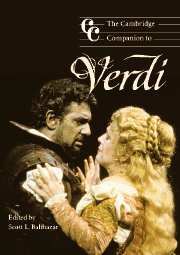Book contents
- Frontmatter
- Part I Personal, cultural, and political context
- Part II The style of Verdi's operas and non-operatic works
- 4 The forms of set pieces
- 5 Newcurrents in the libretto
- 6 Words and music
- 7 French influences
- 8 Structural coherence
- 9 Instrumental music in Verdi's operas
- 10 Verdi's non-operatic works
- Part III Representative operas
- Part IV Creation and critical reception
- Notes
- List of Verdi's works
- Select bibliography and works cited
- Index
9 - Instrumental music in Verdi's operas
from Part II - The style of Verdi's operas and non-operatic works
Published online by Cambridge University Press: 28 September 2011
- Frontmatter
- Part I Personal, cultural, and political context
- Part II The style of Verdi's operas and non-operatic works
- 4 The forms of set pieces
- 5 Newcurrents in the libretto
- 6 Words and music
- 7 French influences
- 8 Structural coherence
- 9 Instrumental music in Verdi's operas
- 10 Verdi's non-operatic works
- Part III Representative operas
- Part IV Creation and critical reception
- Notes
- List of Verdi's works
- Select bibliography and works cited
- Index
Summary
My essay is concerned with the overtures (sinfonie) and preludes; the storms and battle scenes; the stage music accompanying marching armies, religious ceremonies, dances, and balls; ballets, and shorter episodes of pantomime; and certain other episodes where the burden of the musical argument is carried by the orchestra. This is the music by means of which Verdi places his operas in their social frame; since so much of it functions as sounding décor and sounding spectacle, it provides some of the most thought-provoking insights into how he wished his operas to be staged; it also forms the locus for some of his boldest experiments in exploring the balance between “realism” and stylization in the operatic medium.
Verdi's overtures enjoy a life of their own – that is, independent of the operas to which they belong – less securely than those of the German tradition, less securely indeed than Rossini's overtures. One reason is certainly that they are less firmly rooted in a Classical, sonata-based symphonic ideal. Verdi knew those German overtures, and occasional traces of their influence are discernible; but in general his sinfonie occupy a space fascinatingly poised between the symphonic ideal and the idea of a potpourri, a medley or parade of themes from the body of the opera. What gives them their distinctive Verdian character is the manner in which the themes are set out: the formal framework plays on our sense of movement, alternating kinetic or transient episodes with episodes that seem suspended in time, in a manner that is surely evocative of an operatic scena. And though they may fall into several movements, they typically highlight a slow cantabile and a rousing Allegro.
- Type
- Chapter
- Information
- The Cambridge Companion to Verdi , pp. 154 - 168Publisher: Cambridge University PressPrint publication year: 2004



